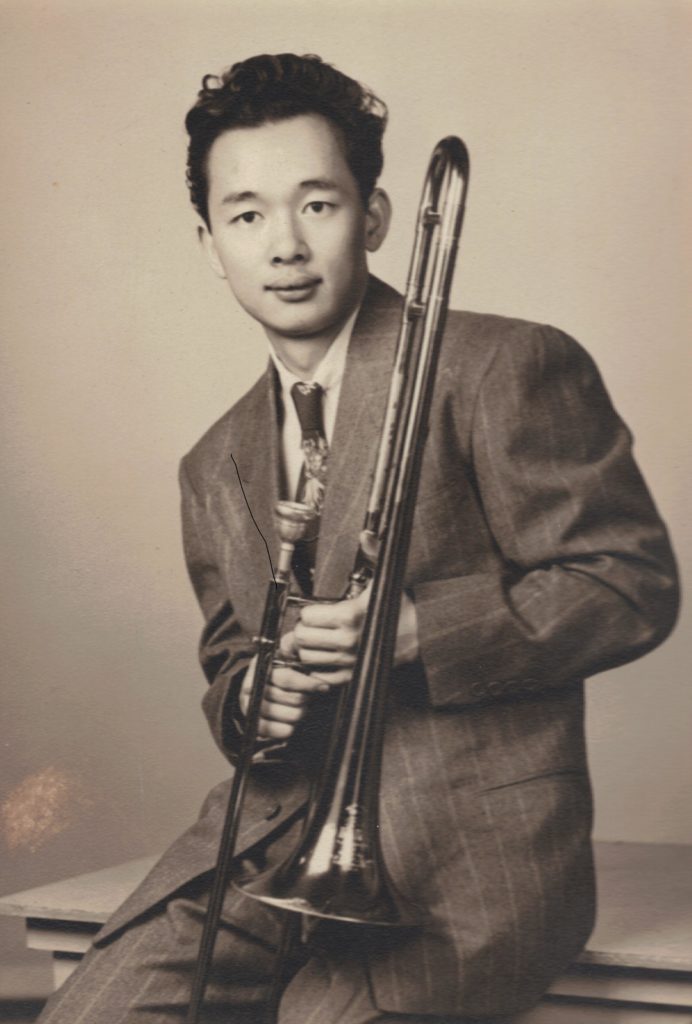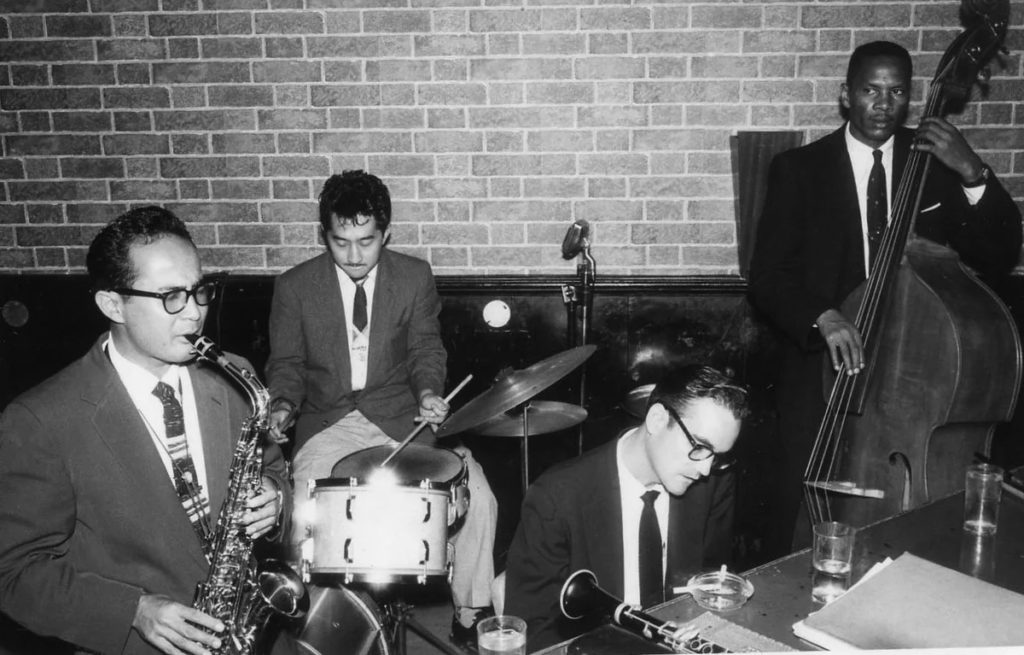August 18, 2022
As the music genre that defined the United States for the first half of the 20th century, jazz had a deep impact on Japanese Americans. For many Nisei, music served as both an inspiration and outlet during the difficult years of the incarceration, and several left camp to pursue brief careers as musicians. As George Yoshida described in his book Reminiscing in Swingtime, these Nisei possessed the “creative energy, irrepressible vitality, and spirituality” of making popular American music and likewise impacted the genre. Here are four stories of Nisei who left their mark on the jazz world.
James “Jimmie” Araki
Perhaps the most transnational Nisei jazz artist, Jimmie Araki (1925 – 1991) became noted as the man who brought bebop to Japan. Originally from Salt Lake City, Araki spent his adolescence in Los Angeles. Following Pearl Harbor, Araki and his family found themselves incarcerated at the Gila River concentration camp in Arizona. After briefly learning the clarinet at Gila River’s Butte High School, Araki enlisted in the Military Intelligence Service and joined their swing band. Araki proved to be a gifted musician: fellow bandmate George Yoshida recalled seeing him pick up the clarinet, saxophone, trumpet, and piano with ease.

In 1946, the Army sent Araki to Japan to serve in the Occupation. Promoted to the rank of lieutenant, Araki worked as a translator for the Allied Translator and Interpreter Section of General Headquarters in Tokyo. As a jazz musician, Araki arrived at the right time in Japan; after years of government bans of jazz, Japanese listeners actively sought out jazz music in the postwar scene.
By 1948, the 22-year-old Araki found himself at the top of the Tokyo jazz scene. Nisei journalist Mas Manbo profiled Araki in an article for The Nippon Times, dubbing Araki a “soldier-swingcat,” and added that most Japanese musicians described Araki as “far superior.”
Musicians in Japan described his talents as “godlike,” and thus bestowed upon Araki the moniker of “kamisama.” After his service in Japan, Araki continued to lead bands in Los Angeles, and recorded with Lionel Hampton. He eventually pursued a career in academia as an expert on classical Japanese literature.
Harry Kitano
Already well-known for his career as a historian and sociologist of Japanese Americans, Harry Kitano (1926-2002) first achieved success as a talented trombonist. Originally from San Francisco, the 16-year-old Kitano and his family were incarcerated at the Topaz concentration camp in Utah in 1942. During his time at Topaz, Kitano played trombone with the camp’s swing band Starlight Serenaders.

In 1944, Kitano left Topaz and settled in Chicago to start up his own jazz career. He responded to an ad in the famed jazz magazine DownBeat, and joined a jazz ensemble in Minnesota led by Oscar Pettiford, one of the most well-known band leaders at the time. To hide his Japanese American identity, he changed his name to “Harry Lee.” The group toured throughout the Midwest, which proved a liberating experience for the young Kitano:
“I enjoyed life as a musician—it was fun to play with professional musicians of varying quality—to travel from town to town on one-nighters, especially after having been cooped up in a camp for several years—to eat out at restaurants with big steaks, and to live an independent and carefree life.”
In 1946, Kitano, believing his ancestry would get in the way of his becoming a famous bandleader, returned to California. He enrolled at UC Berkeley, where he majored in psychology. He continued to tour with his band “Harry Lee and his orchestra” during his time as a student. Kitano later pursued a master’s in social work and a doctorate in psychology, and joined the faculty at UCLA. He devoted his career to studying the psychological impacts of the incarceration upon Japanese Americans.
Paul Higaki
To some, he was the one who “made it big.” The first Nisei jazz musician to play with a major orchestra, Paul Higaki (1924 – 1973) was a talented performer. Born in San Francisco on July 28, 1924, Higaki first played trombone while in middle school, and he fell in love with the instrument.
Throughout his incarceration experience, Higaki formed several popular jazz combos: at the Merced Assembly Center, he organized the “Stardusters,” a band that continued to perform after its members’ transfer to Amache concentration camp in Colorado. After the army announced the creation of the 442nd Regimental Combat Team in 1943, Higaki volunteered. His service was cut short when the army discharged him on medical grounds. Freed from camp, he returned to music. After gigging with several small bands, Higaki received an invitation from Lionel Hampton to join his orchestra.
Higaki performed with Lionel Hampton’s orchestra for the next several years. At the height of his career in 1950, Higaki was the sole Nisei working for a major jazz orchestra. On July 22, 1950, the Hampton orchestra performed at the Golden Gate Theater. The performance, which was televised live and recorded on radio, likely represents the first time a Nisei performed on television. Hampton singled out Higaki as “one of the new names in jazz today.” Higaki received congrats from several big-name celebrities, including Walter Winchell, Jackie Robinson, and Ed Sullivan.
Nonetheless, Higaki faced discrimination throughout his career. Ironically, the worst prejudice came from his being classified as “white.” When touring with Hampton in the Deep South, he was forced to find separate lodging from his fellow bandmates, and was told by white stage managers not to blow his trombone during concerts for fear of violating segregationist laws.
Later in his career, Higaki moved to Reno, Nevada. He found work at several casinos and played classical trombone as a member of the Reno Symphony. He returned to school in 1967 for training to become a music teacher. Tragically, Higaki and his wife Bonnie were shot to death on December 20, 1973, shortly following a performance.
Paul Togawa
The youngest of the Nisei jazz musicians, Paul Togawa (1932-2018) rose to prominence as a drummer for several jazz orchestras during the 1950s. Born in 1932 in Los Angeles, he took up drumming while incarcerated at Poston concentration camp. Following his return from Poston, Togawa completed his studies at Theodore Roosevelt High School in 1950. At 20, he signed with Lionel Hampton’s orchestra, and toured the East Coast. As part of the tour, Togawa performed at President Dwight Eisenhower’s 1953 inaugural ball. After briefly serving in the army, Togawa returned to performing. While in Los Angeles, Togawa formed the Miyako Trio with George Aisumo on saxophone and Jimmie Araki on piano. In 1957, Togawa formed his own Paul Togawa Quartet with a former Army buddy Gabe Baltazar. The group cut their first self-titled album in 1957, and featured pianist Dick Johnston and bassist Ben Tucker.

Togawa maintained a steady career as a studio drummer. He recorded alongside the likes of Miles Davis, Quincy Jones, Art Pepper, and Anthony Ortega. On top of his musical career, Togawa pursued a career as an actor. Initially casted in his first role as a Japanese soldier in Battle of the Coral Sea, his screen credits included McHale’s Navy, Flower Drum Song, Hell to Eternity, and North by Northwest.
—
By Jonathan van Harmelen
Jonathan van Harmelen is a Ph.D candidate in History at UC Santa Cruz. He is currently working as a writer for Densho’s blog and encyclopedia with support from UC Santa Cruz’s The Humanities Institute.
[Header: High school students practicing in the brass band at Rohwer concentration camp. Courtesy of the National Archives and Records Administration.]
